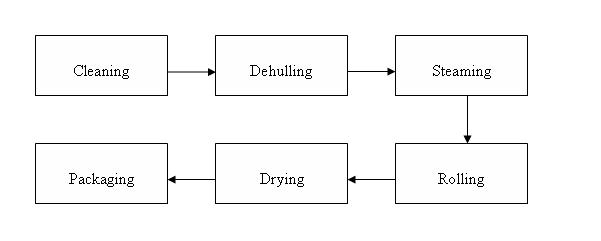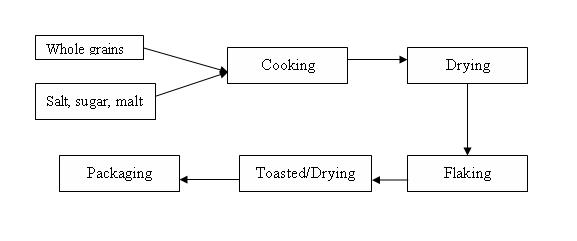Information about Breakfast cereals
Back to EFFICENCY FINDER OF FOOD INDUSTRY
Back to Information about bread, biscuits & cakes production
1. GENERAL DESCRIPTION:
- 1. General Flowsheet of bread production
Figure 1: Flow sheet diagram for the production of HC
Figure 2: Flow sheet diagram for the production of flaked cereals
- 2. Description of techniques, methods and equipment
(BAT for Food, Drink and Milk Industries, June 2005)
Breakfast Cereals (BC) have been defined as processed grains for human consumption. The major grains used in manufacture are corn, rice, wheat, oats and barley. Furthermore BC can be divided into two groups: Ready-to-eat (RTE) and hot cereals (HC) or ready- to-cook. RTE Cereals are frequently made from mixtures of one or several grain components with other ingredients. Extensive processing is required and vitamins and other minerals are added. They packaged in special ways to protect their flavour, texture and nutrition during storage. The group of RTE cereals include products such as flaked cereals, puffed cereals, shredded cereals, granola cereals and extruded expanded cereals. HC are made from a single grain component and only relatively simple processing and packaging technologies are required. Comparing the prices at the consumers’ level reflects a higher prize for a single serving of RTE cereals for the costumers. HC have to be cooked or heated in water before consumption. Important HC are wheat farina, cracked wheat and bulgur and corn grits.
- 3. Temperature ranges and other parameters
- 4. Benchmark data
2. NEW TECHNOLOGIES:
- a) Changes in the process
- b) Changes in the energy distribution system
- c) Changes in the heat supply system
Reference: Caballero, B., Finglas, P., Trugo, L.: Encyclopedia of food science and nutrition, Academic Pr. Inc., 2003, pages 1023-1027
Back to EFFICENCY FINDER OF FOOD INDUSTRY
Back to Information about bread, biscuits & cakes production

